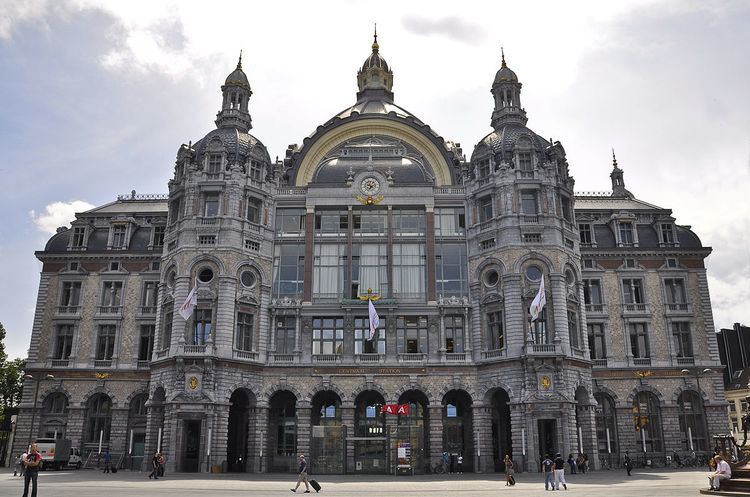Line(s) 4, 12, 25, 27 Station code ANTC Opened 11 August 1905 Platforms in use 14 | Platform levels 4 Address 2018 Antwerp, Belgium Level 4 Architect Louis Delacenserie | |
 | ||
Location Koningin Astridplein, Antwerp Owned by National Railway Company of Belgium Owner National Railway Company of Belgium Similar Antwerpen‑Berchem railway station, Rubenshuis, Cathedral of Our Lady, Brussels‑South railway station, Museum aan de Stroom | ||
Antwerpen-Centraal (Antwerp Central) is the name of the main railway station in the Belgian city of Antwerp. The station is operated by the national railway company NMBS.
Contents
History and architecture
The original station building was constructed between 1895 and 1905 as a replacement for the original terminus of the Brussels-Mechelen-Antwerp Railway. The stone clad terminus buildings, with a vast dome above the waiting room hall were designed by Louis Delacenserie. The viaduct into the station is also a notable structure designed by local architect Jan Van Asperen. A plaque on the north wall bears the name Middenstatie.
The station is now widely regarded as the finest example of railway architecture in Belgium, although the extraordinary eclecticism of the influences on Delacenserie's design had led to a difficulty in assigning it to a particular architectural style. In W. G. Sebald's novel Austerlitz an ability to appreciate the full range of the styles that might have influenced Delacensiere is used to demonstrate the brilliance of the fictional architectural historian who is the novel's protagonist.
In 2009 the American magazine Newsweek judged Antwerpen-Centraal the world's fourth greatest train station. In 2014 the British-American magazine Mashable awarded Antwerpen-Centraal the first place for the most beautiful railway station in the world.
Train hall
The originally iron and glass train hall (185 metres long and 44 metres or 43 metres high) was designed by Clément Van Bogaert, an engineer, and covers an area of 12,000 square metres. The height of the station was once necessary for the steam of locomotives. The roof of the train hall was originally made of steel.
World War II damage and restoration
During World War II, severe damage was inflicted to the train hall by the impact of V-2 bombs, without destroying the structural stability of the building, according to National Railway Company of Belgium. Nevertheless, it has been claimed that the warping of the substructure due to a V-2 bomb had caused constructional stresses.
The impact of the bombs are still visible due to a lasting wave-distortion in the roofing of the hall.
In the mid-twentieth century, the building's condition had deteriorated so far that its demolition was being considered. The station was closed on 31 January 1986 by the National Railway Company of Belgium for safety reasons, after which the same National Railway Company of Belgium started performing restoration work to the roof (starting at the end of March 1986, and finishing in September 1986) and façades.
The stress problems due to the impact of bombs during the war was reportedly solved by the use of polycarbonate sheets instead of glass, due to its elasticity and its relatively low weight (40% less than glass), which avoided the need for extra supporting pillars.
After replacing or repairing steel elements, they were painted in a burgundy colour. Copper was also used during the renovation process of the roof.
Expansion for high-speed trains
In 1998 large-scale reconstruction work began to convert the station from a terminus to a through station. A new tunnel has been excavated between Berchem station in the south of the city and Antwerpen-Dam station in the north, passing under Central station, with platforms on two underground levels. This allows Thalys, HSL 4 and HSL-Zuid high-speed trains to travel through Antwerp Central without the need to turn around (the previous layout obliged Amsterdam-Brussels trains to call only at Berchem or reverse at Central).
The major elements of the construction project were completed in 2007, and the first through trains ran on 25 March 2007.
This complete project has cost approximately €1.6 billion.
The station was awarded a Grand Prix at the European Union Prize for Cultural Heritage / Europa Nostra Awards in 2011.
Station layout
The station has four levels and 14 tracks arranged as follows:
Train services
The station is served by the following services:
In popular culture
A staged "flash mob"-like event at the station in early 2009, featuring the song "Do-Re-Mi" from the Rodgers and Hammerstein musical The Sound of Music, became a viral video. It was performed by 200 dancers of various ages, along with several dozen waiting passengers who just jumped in and joined the dance themselves. The video was produced to publicize Op zoek naar Maria, the Belgian TV version of the BBC talent competition programme How Do You Solve a Problem Like Maria?, about the search for an actress to play the lead role in a stage revival of The Sound of Music.
The station is used in Agatha Christie's Poirot episode "The Chocolate Box" to represent a station in Brussels.
The beginning of Austerlitz, the final novel of the German writer W. G. Sebald is set in the station.
